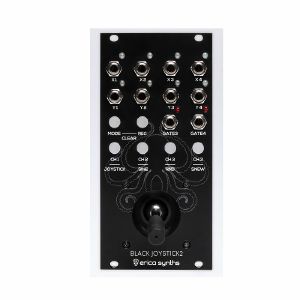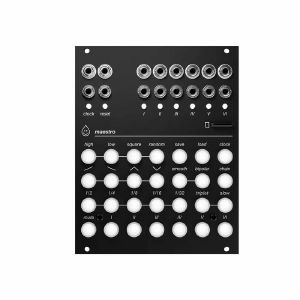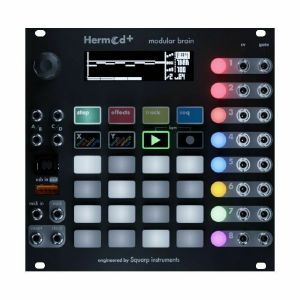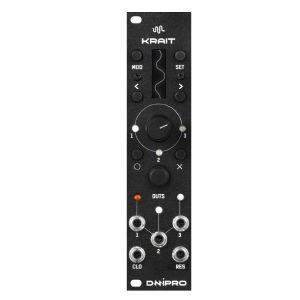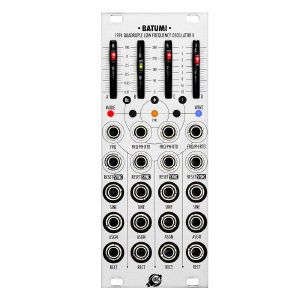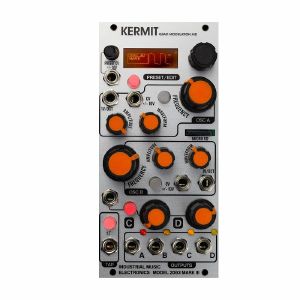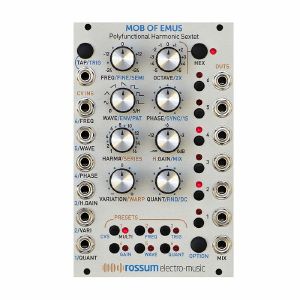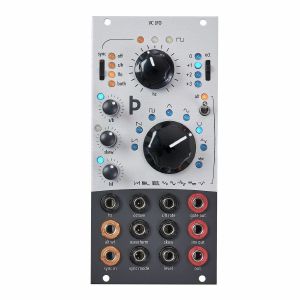Filter
Equipment
Format
Brand
Featured
Price
Tags: LFO module
Products tagged as LFO module
Items 1 to 8 of 8 on page 1 of 1
Erica Synths Black Joystick2 4-Channel Recordable Joystick Controller Module (controller synth module)
Cat: 812600 Rel: 23 Feb 21
8-channel multi-functional CV source, joystick, movement recorder & distinct LFO module - 12HP
Notes: Multi-function eight-channel LFO, joystick, movement recorder and drone oscillator that packs in lots more functionality than you might expect. A real modulation powerhouse in a compact format.
Supplier's Notes:
Erica Synths Black Joystick2 is 8 channel multi functional CV and sound source - joystick, movement recorder, distinct LFO and drone/noise oscillator. It provides great interaction with the modular system and allows to develop unconventional modulation patterns instantly.
… Read moreSupplier's Notes:
Erica Synths Black Joystick2 is 8 channel multi functional CV and sound source - joystick, movement recorder, distinct LFO and drone/noise oscillator. It provides great interaction with the modular system and allows to develop unconventional modulation patterns instantly.
1 in stock $236.59
Acid Rain Technology Maestro 6-Channel Clocked Modulation Controller Module (clock generator/clock modulator/controller/CV modulation/envelope generator/LFO/random/sequencer module)
Cat: 804571 Rel: 22 Jan 21
6-channel clocked modulation module
Notes: Maestro is a 6 channel clocked modulation controller inspired by the automation lanes found in digital audio workstation software, brought into eurorack and made playable and performable. Maestro will push and pull the parameters of your other modules with rapid or slowly evolving voltages, always in perfect sync with eachother and the rest of your system.
Details:
20hp
25mm deep
65mA on +12, 18mA on -12, 0mA on 5V
… Read moreDetails:
20hp
25mm deep
65mA on +12, 18mA on -12, 0mA on 5V
1 in stock $399.11
Click for better price!
or call +44 20 7424 1960
quote 804571
quote 804571
Squarp Instruments Hermod+ Modular Brain 16-Track MIDI Polyphonic Sequencer Module (sequencer synth module)
Cat: 973086 Rel: 27 Oct 23
16-track MIDI polyphonic sequencer module - 26HP.
Notes: *** Firmware update- February 2025 ***
Hermod+OS2.00
Again, a major firmware upgrade packed with exciting new features. This update offers a wealth of new creative tools and improvements.
Audio tuner
4 internal automation per track - MOD, MOD2, MOD3, MOD4
Automation per track : 7 (4x modulations + pitchbend + aftertouch + sustain
***
Parisian sequencer specialists Squarp turn up the goods once again with the updated Hermod+ module. Huge sequencing power for both MIDI and CV, with a range of monophonic and polyphonic features to get the most out of your sound sources.
Supplier's Notes:
Hermod+ adds so much to your system.
Based on the established Hermod workflow and keeping the same form factor, Hermod+ offers a lot of new features, and a refined, more playful interface with extended connectivity.
Record CV/Gate, MIDI notes and modulations on 16 polyphonic tracks. Compose melodic variations across 16 patterns per track, and take advantage of the advanced step sequencer and the new effects to gain efficiency and creativity in studio and on stage.
8 CV/Gate and 8 MIDI tracks
Hermod+ offers 8 CV/Gate tracks (that can also output midi) and adds 8 dedicated MIDI tracks for your extra gear.
CV inputs
Record, edit and loop analogue modulations or CV/Gate using the 4 CV inputs, and use them to synchronize Hermod+ to an incoming analogue clock.
Record live
With an improved resolution of 96ppqn, record and playback your CV/Gate or MIDI performance seamlessly without any noticeable note shifting, for up to 16 bars per pattern.
Polyphonic step composer
The revisited piano-roll now allows intuitive polyphonic editing. Edit or program chords, melodies and rhythms using the 16 built-in pads for a quick and playful composition process.
Automation
Program or record automated modulations (CV and/or MIDI) for each track, in addition to midi aftertouch, pitchbend and sustain voices.
Dynamic effects
Add up to 8 real-time CV/MIDI effects per track. All effects are non-destructive, so they can be edited at any given time to add some variations to a performance.
Advanced ModMatrix
Use the modulation matrix to link incoming CV or CC messages to effect parameters. Each modulations can be attenuverted and offsetted.
Playable song mode
Build your song structures using up to 16 sequences per project. Play them into a predefined order or launch them manually for improvised performances.
Synchronized project swap
Quickly save and recall your projects on the SD card. Project loading can now be done in sync, without interrupting your performance.
Boosted connectivity.
The missing link between your eurorack system and the rest of your studio.
Editing made simple.
Fluid workflow with a redesigned Step mode
Step mode is where you can edit notes, modulations and gate events. Hermod+ offers quick ways to write melodies and rhythms. Zoom in and out to visualize and edit portions of your track precisely and break free from rigid grid sequencing.
The re-designed piano roll editor makes the vertical and horizontal scrolling easier and faster, while the new "row edit" feature allows for quick chords and drum patterns programming.
Create modulation curves by programming them directly on Hermod+ or by recording incoming signals, and send those curves via CV or MIDI to other parts of your system.
Versatile interface.
Polymorphic layouts for perfect integration
Hermod+ can adapt its voice layout to any patching scenario. Depending on your needs, any track can become a modulation output, a monophonic CV/Gate track, a polyphonic MIDI track...
For a track of CV/Gate note + velocity + aftertouch, or for a polyphonic CV/Gate track, simply group voices using the desired layout.
Take advantage of the 8 dedicated MIDI tracks, that can record and be programmed independently from the 8 CV/Gate tracks. Up to 8 real-time effects per track with creative parameters and generative features. Hermod+ is the canvas, the paint and the brush of your setup.
Specifications
Sequencer
Tracks: 8 CV/Gate + 8 MIDI
Patterns: 16 per track
Recording resolution: 96ppqn
Track length: 1/16 note to 16 bars
Automation per patterns: modulation + pitchbend + aftertouch + sustain
Projects
Amount of projects: unlimited
Tempo: 10 to 280 BPM
Global transpose track: yes
Double project architecture: yes
Song chain length: 64 sequences
Piano roll
Zoom min: /4 (1 step = 1/4 note = 1 beat)
Zoom max: X8 (1 step = 1/128 note)
Note/gate width: 1/32 (1/512 note) to 8 bars
Maximum polyphony per step: 24
Row edit (polyphony editing): yes
Note pitch: C0 to C10
Note velocity: 0 to 127
Synchonization clock speed
Max input rate: 1/96 = 24ppqn
Max output rate: 1/96 = 24ppqn
Input
MIDI: TRS type A + USB host + USB device
CV: 4x [-5V to +5V]
Output
MIDI: TRS (type A) + USB host + USB device
CV: 8x [-5V to +5V]
GATE: 8x [0V / +5V]
Dedicated Clock port
Dedicated Reset port for transport
Power
Note: the use of your eurorack +5V rail is configurable with a switch on the back of Hermod+
Consumption (using +5V rail): -12V 20mA, +12V 20mA, +5V 820mA (add up to +500mA when attaching a controller on USB host)
Consumption (not using +5V rail): -12V 20mA, +12V 400mA (add up to +220mA when attaching a controller on USB host)
Hardware
Width: 26HP
Depth: 20mm
Weight: 285gr (0.63lbs)
CV inputs resolution: 16-bit
CV outputs resolution: 16-bit
Display: OLED 58 x 16mm
SD card: microSD high speed (provided)
CPU: ARM 480MHz
… Read moreHermod+OS2.00
Again, a major firmware upgrade packed with exciting new features. This update offers a wealth of new creative tools and improvements.
Audio tuner
4 internal automation per track - MOD, MOD2, MOD3, MOD4
Automation per track : 7 (4x modulations + pitchbend + aftertouch + sustain
***
Parisian sequencer specialists Squarp turn up the goods once again with the updated Hermod+ module. Huge sequencing power for both MIDI and CV, with a range of monophonic and polyphonic features to get the most out of your sound sources.
Supplier's Notes:
Hermod+ adds so much to your system.
Based on the established Hermod workflow and keeping the same form factor, Hermod+ offers a lot of new features, and a refined, more playful interface with extended connectivity.
Record CV/Gate, MIDI notes and modulations on 16 polyphonic tracks. Compose melodic variations across 16 patterns per track, and take advantage of the advanced step sequencer and the new effects to gain efficiency and creativity in studio and on stage.
8 CV/Gate and 8 MIDI tracks
Hermod+ offers 8 CV/Gate tracks (that can also output midi) and adds 8 dedicated MIDI tracks for your extra gear.
CV inputs
Record, edit and loop analogue modulations or CV/Gate using the 4 CV inputs, and use them to synchronize Hermod+ to an incoming analogue clock.
Record live
With an improved resolution of 96ppqn, record and playback your CV/Gate or MIDI performance seamlessly without any noticeable note shifting, for up to 16 bars per pattern.
Polyphonic step composer
The revisited piano-roll now allows intuitive polyphonic editing. Edit or program chords, melodies and rhythms using the 16 built-in pads for a quick and playful composition process.
Automation
Program or record automated modulations (CV and/or MIDI) for each track, in addition to midi aftertouch, pitchbend and sustain voices.
Dynamic effects
Add up to 8 real-time CV/MIDI effects per track. All effects are non-destructive, so they can be edited at any given time to add some variations to a performance.
Advanced ModMatrix
Use the modulation matrix to link incoming CV or CC messages to effect parameters. Each modulations can be attenuverted and offsetted.
Playable song mode
Build your song structures using up to 16 sequences per project. Play them into a predefined order or launch them manually for improvised performances.
Synchronized project swap
Quickly save and recall your projects on the SD card. Project loading can now be done in sync, without interrupting your performance.
Boosted connectivity.
The missing link between your eurorack system and the rest of your studio.
Editing made simple.
Fluid workflow with a redesigned Step mode
Step mode is where you can edit notes, modulations and gate events. Hermod+ offers quick ways to write melodies and rhythms. Zoom in and out to visualize and edit portions of your track precisely and break free from rigid grid sequencing.
The re-designed piano roll editor makes the vertical and horizontal scrolling easier and faster, while the new "row edit" feature allows for quick chords and drum patterns programming.
Create modulation curves by programming them directly on Hermod+ or by recording incoming signals, and send those curves via CV or MIDI to other parts of your system.
Versatile interface.
Polymorphic layouts for perfect integration
Hermod+ can adapt its voice layout to any patching scenario. Depending on your needs, any track can become a modulation output, a monophonic CV/Gate track, a polyphonic MIDI track...
For a track of CV/Gate note + velocity + aftertouch, or for a polyphonic CV/Gate track, simply group voices using the desired layout.
Take advantage of the 8 dedicated MIDI tracks, that can record and be programmed independently from the 8 CV/Gate tracks. Up to 8 real-time effects per track with creative parameters and generative features. Hermod+ is the canvas, the paint and the brush of your setup.
Specifications
Sequencer
Tracks: 8 CV/Gate + 8 MIDI
Patterns: 16 per track
Recording resolution: 96ppqn
Track length: 1/16 note to 16 bars
Automation per patterns: modulation + pitchbend + aftertouch + sustain
Projects
Amount of projects: unlimited
Tempo: 10 to 280 BPM
Global transpose track: yes
Double project architecture: yes
Song chain length: 64 sequences
Piano roll
Zoom min: /4 (1 step = 1/4 note = 1 beat)
Zoom max: X8 (1 step = 1/128 note)
Note/gate width: 1/32 (1/512 note) to 8 bars
Maximum polyphony per step: 24
Row edit (polyphony editing): yes
Note pitch: C0 to C10
Note velocity: 0 to 127
Synchonization clock speed
Max input rate: 1/96 = 24ppqn
Max output rate: 1/96 = 24ppqn
Input
MIDI: TRS type A + USB host + USB device
CV: 4x [-5V to +5V]
Output
MIDI: TRS (type A) + USB host + USB device
CV: 8x [-5V to +5V]
GATE: 8x [0V / +5V]
Dedicated Clock port
Dedicated Reset port for transport
Power
Note: the use of your eurorack +5V rail is configurable with a switch on the back of Hermod+
Consumption (using +5V rail): -12V 20mA, +12V 20mA, +5V 820mA (add up to +500mA when attaching a controller on USB host)
Consumption (not using +5V rail): -12V 20mA, +12V 400mA (add up to +220mA when attaching a controller on USB host)
Hardware
Width: 26HP
Depth: 20mm
Weight: 285gr (0.63lbs)
CV inputs resolution: 16-bit
CV outputs resolution: 16-bit
Display: OLED 58 x 16mm
SD card: microSD high speed (provided)
CPU: ARM 480MHz
2 in stock $517.40
Click for better price!
or call +44 20 7424 1960
quote 973086
quote 973086
Dnipro Krait 3-Channel Knob Recorder/LFO/Random Generator Module (controller/LFO/random synth module)
Cat: 846610 Rel: 01 Nov 21
A 3-channel knob recorder, LFO & random generator.
Notes: Dnipro serve up a solid option for generating modulation signals: knob recording, LFOs or loopable random modulation, all syncable to a clock signal. Nice touches include tap tempo and slew.
Supplier's Notes:
Krait is flexible 3-channel modulation source for eurorack system. Each channel can be either a Knob Recorder, LFO or loopable Random Generator.
The module is designed to be in solid sync with your beats, so in order to work, Krait should receive steady external clock pulse. However, LFO will work without clock. All settings and waveforms will be autosaved and reloaded after power off.
Knob Recorder:
Can record pot turns, up to 8 bars loops possible.
LFO:
Tap tempo LFO with morphable waveforms and phase offset. Sync it to your beats.
Random Generator:
Syncable random with portamento and possibility to freeze and loop 16 steps.
Technical details:
6 HP
70 mA +12V
12mA -12V
0 mA 5V
42 mm deep
Voltage ranges: +5-5v, 0v+5v
… Read moreSupplier's Notes:
Krait is flexible 3-channel modulation source for eurorack system. Each channel can be either a Knob Recorder, LFO or loopable Random Generator.
The module is designed to be in solid sync with your beats, so in order to work, Krait should receive steady external clock pulse. However, LFO will work without clock. All settings and waveforms will be autosaved and reloaded after power off.
Knob Recorder:
Can record pot turns, up to 8 bars loops possible.
LFO:
Tap tempo LFO with morphable waveforms and phase offset. Sync it to your beats.
Random Generator:
Syncable random with portamento and possibility to freeze and loop 16 steps.
Technical details:
6 HP
70 mA +12V
12mA -12V
0 mA 5V
42 mm deep
Voltage ranges: +5-5v, 0v+5v
1 in stock $277.49
Click for better price!
or call +44 20 7424 1960
quote 846610
quote 846610
Xaoc Devices Batumi II 1974 Quadruple Low Frequency Oscillator Module (oscillator synth module)
Cat: 979276 Rel: 13 Feb 24
Quadruple low frequency oscillator module - 10HP
Notes: An updated version of the excellent Batumi quad LFO, version II introduces performance updates plus compatibility with the new Poti II expander. Original Poti I breakout functions are now included in the Batumi II.
Supplier's Notes:
Xaoc Devices presents Batumi II - a greatly improved and enhanced new iteration of the modern day classic that is/was the original Batumi, preserving its layout and form factor. The premise remains the same: four LFO's with individual outputs for sine, assign and rectangle waves. The channels can operate independently or they can be linked - phase shifted, divided or multiplied (new mode alert) with regard to the first channel. Multiple major and minor improvements have been implemented, e.g. when synced to an external clock source, each channel's frequency slider selects a clock division for that channel's outputs.
Xaoc Devices have managed to incorporate the features of the original expander into Batumi II (sync mode switching and assign waveform selection) without changing the size of the module which opened up new possibilities for the new optional expander. The Poti II expander for Batumi II adds multi destination inputs for sine wavefolding, assign output waveform selection or rectangle pulse modulation with the destination set for each channel independently. Poti II also features frequency input attenuation as well as sine and assign output attenuation. All adjustments may be performed separately for each individual channel or for all channels simultaneously.
The Batumi II software has been rewritten from scratch to ensure best performance. The hardware has also been updated to allow for V/oct tracking and stable operation up to audio rates (more powerful CPU, precise, wideband converters, antialiased waveforms).
-4 LFO's
- redesigned from scratch - both the hardware and software
- new waveforms for the assign output (including random)
- new frequency multiplication mode
- all features of the Poti expander incorporated into the main module
- very wide frequency range well into audio rate
- 1V/oct tracking = so can be used as 4 VCO's
- in the Phase/Divide/Mult modes the random waves at the ASGN output follow the values available in the master/A channel
- 10HP
- +90/-50mA
… Read moreSupplier's Notes:
Xaoc Devices presents Batumi II - a greatly improved and enhanced new iteration of the modern day classic that is/was the original Batumi, preserving its layout and form factor. The premise remains the same: four LFO's with individual outputs for sine, assign and rectangle waves. The channels can operate independently or they can be linked - phase shifted, divided or multiplied (new mode alert) with regard to the first channel. Multiple major and minor improvements have been implemented, e.g. when synced to an external clock source, each channel's frequency slider selects a clock division for that channel's outputs.
Xaoc Devices have managed to incorporate the features of the original expander into Batumi II (sync mode switching and assign waveform selection) without changing the size of the module which opened up new possibilities for the new optional expander. The Poti II expander for Batumi II adds multi destination inputs for sine wavefolding, assign output waveform selection or rectangle pulse modulation with the destination set for each channel independently. Poti II also features frequency input attenuation as well as sine and assign output attenuation. All adjustments may be performed separately for each individual channel or for all channels simultaneously.
The Batumi II software has been rewritten from scratch to ensure best performance. The hardware has also been updated to allow for V/oct tracking and stable operation up to audio rates (more powerful CPU, precise, wideband converters, antialiased waveforms).
-4 LFO's
- redesigned from scratch - both the hardware and software
- new waveforms for the assign output (including random)
- new frequency multiplication mode
- all features of the Poti expander incorporated into the main module
- very wide frequency range well into audio rate
- 1V/oct tracking = so can be used as 4 VCO's
- in the Phase/Divide/Mult modes the random waves at the ASGN output follow the values available in the master/A channel
- 10HP
- +90/-50mA
! low stock $313.98
Industrial Music Electronics Kermit Mark III Quad Modulation Aid Module (modulation synth module)
Cat: 757220 Rel: 01 Apr 20
4-channel programmable supermodulator module - 12HP
Notes: Kermit is a 4-channel programmable supermodulator with morphing wavetable generator and internal modulation matrix. Four channels operate as LFOs, audio rate oscillators (with 1v/octave response on two channels), 1-shot envelopes, random voltage generators, or sample-and-holds, all responding to manual control, external control voltages, or synchronization to the module's master tap tempo clock. Designed for maximum patching power in small systems, Kermit carries an unmatched functionality-per-HP factor with an easily readable display that shows parameters in their real-world units.
The module has a 16-bit DAC to accurately render subtle changes of voltage at extremely low frequencies. The oscillator mode is best suited for bass frequencies, and the waveform "character" modes restrict the morph behavior or degenerate the audio to a minimum of 8 bits with limited horizontal resolution, like the Konami SCC chip used with the MSX computer. The tap tempo facility features an input jack and a manual button. The tempo is shown on the OLED display in BPM. The relevant units (hertz, seconds, volts, etc) or selected waveform of each channel are contextually shown on the display as the user programs the module.
List of operating modes per channel:
LFO (1 volt/octave)
LFO (with reset)
Tap tempo LFO
Audio oscillator
Audio oscillator (unison)
Code scan
1-shot envelope
Gated repeat envelope
Tap tempo envelope
Smooth random
Stepped random
Tap tempo stepped random
Sample-and-hold
Track-and-hold
Tap Tempo sample-and-hold
Three parameters on each channel can be modulated: frequency, amplitude, or waveform. Both external CV input and internal cross modulation are programmable with hotkeys. For example: assign the output of Channel B to morph the waveform of Channel A by holding the Channel B button while turning the Channel A Waveform knob. All channels have manual control of frequency (coarse and fine), phase, wave bank, waveform morph, and amplitude. Channels A and B have full controls, C and D have single knob controls with deep parameters accessible by hotkey combinations. Still deeper functions are accessible through the Mark III menu system.
Kermit has a microSD card slot for loading custom waveforms, like its big brother Piston Honda. The SD card accepts one .WAV file in WaveEdit format (free software editor) containing 64 waveforms, also compatible with several other Eurorack modules. When loaded into Kermit, the waveforms are organized into 8 banks of 8 waveforms each. Each oscillator can select any of the 8 banks, and the 8 constituent waves can be smoothly morphed from one to another.
The Mark III morphing preset manager is in full effect on Kermit. The discrete preset mode quickly and reliably recalls all parameters in response to triggers or CV, accessing the true power of the module as detailed, carefully programmed settings are effortlessly loaded and changed. The morphing mode causes delightfully unexpected variations of the basis preset.
Insert a master clock signal and you're ready to go. Kermit is a reliable provider of endless rhythmically coherent modulation voltages and a reasonably competent "voice module" providing most common synthesis functions on each channel with an internal modulation matrix.
… Read moreThe module has a 16-bit DAC to accurately render subtle changes of voltage at extremely low frequencies. The oscillator mode is best suited for bass frequencies, and the waveform "character" modes restrict the morph behavior or degenerate the audio to a minimum of 8 bits with limited horizontal resolution, like the Konami SCC chip used with the MSX computer. The tap tempo facility features an input jack and a manual button. The tempo is shown on the OLED display in BPM. The relevant units (hertz, seconds, volts, etc) or selected waveform of each channel are contextually shown on the display as the user programs the module.
List of operating modes per channel:
LFO (1 volt/octave)
LFO (with reset)
Tap tempo LFO
Audio oscillator
Audio oscillator (unison)
Code scan
1-shot envelope
Gated repeat envelope
Tap tempo envelope
Smooth random
Stepped random
Tap tempo stepped random
Sample-and-hold
Track-and-hold
Tap Tempo sample-and-hold
Three parameters on each channel can be modulated: frequency, amplitude, or waveform. Both external CV input and internal cross modulation are programmable with hotkeys. For example: assign the output of Channel B to morph the waveform of Channel A by holding the Channel B button while turning the Channel A Waveform knob. All channels have manual control of frequency (coarse and fine), phase, wave bank, waveform morph, and amplitude. Channels A and B have full controls, C and D have single knob controls with deep parameters accessible by hotkey combinations. Still deeper functions are accessible through the Mark III menu system.
Kermit has a microSD card slot for loading custom waveforms, like its big brother Piston Honda. The SD card accepts one .WAV file in WaveEdit format (free software editor) containing 64 waveforms, also compatible with several other Eurorack modules. When loaded into Kermit, the waveforms are organized into 8 banks of 8 waveforms each. Each oscillator can select any of the 8 banks, and the 8 constituent waves can be smoothly morphed from one to another.
The Mark III morphing preset manager is in full effect on Kermit. The discrete preset mode quickly and reliably recalls all parameters in response to triggers or CV, accessing the true power of the module as detailed, carefully programmed settings are effortlessly loaded and changed. The morphing mode causes delightfully unexpected variations of the basis preset.
Insert a master clock signal and you're ready to go. Kermit is a reliable provider of endless rhythmically coherent modulation voltages and a reasonably competent "voice module" providing most common synthesis functions on each channel with an internal modulation matrix.
4 in stock $464.33
Click for better price!
or call +44 20 7424 1960
quote 757220
quote 757220
Rossum Electro-Music Mob Of Emus Polyfunctional Harmonic Sextet Module (envelope generator/LFO/oscillator/quantiser/sample & hold/CV modulation/digital/random synth module)
Cat: 797062 Rel: 25 Nov 20
Polyfunctional harmonic sextet module
Notes: *** Free software update available as a free download, along with updated documentation, at the Mob of Emus product page on the Rossum Electro-Music website***
A lot to unpack here. Six-channel multipurpose oscillator/noise source/modulation generator with quantisation, trigger generators and even more. Seriously powerful all-round digital goodness.
Supplier's Notes:
Mob of Emus is a powerful music and sound design tool that packs an enormous amount of creative power into an amazingly compact 16HP module.
Mob of Emus gives you six channels of oscillators, noise sources, cyclical and 1-shot modulators (including LFOs, envelopes, and various other shapes), sample and hold waveshapes, slow random modulators, triggers, rhythm patterns, and quantization (of both internal and external signals) in pretty much any combination (well, any combination of six channels, anyway).
In addition to being able to independently program the function of each individual channel, Mob of Emus' Hex Mode provides a macro control layer that allows you to control all of its channels simultaneously (while maintaining the relationships of each channel's independent programming).
What's more, Mob of Emus' "harmonic" control structure makes it extremely easy to combine its oscillators into rich additive timbres, to combine its LFOs into stacked harmonic low frequency modulation waves, and to create modulation sources and triggers with intricate polyrhythmic patterns.
With an external trigger input, six CV inputs that can operate in six different control modes, six independent outputs, and an assignable mix output, Mob of Emus can operate as the heart of an almost unlimited variety of patches. And its 8 real-time controls will give you immediate hands-on access to a channel's (or all six channels') key parameters, inviting (and rewarding) exploration and improvisation.
Mob of Emus features include:
Six channels that can function independently or can be further controlled by a Hex Mode macro layer that lets you control all six simultaneously. Channels can be:
Wide-range digital oscillators
Noise sources
Cyclical and 1-shot modulators (including LFOs, envelopes, and various other shapes)
Sample and hold waveshapes
Slow random modulators
Triggers
Rhythm patterns
Quantizers (of both internal and external(!) signals)
Six CV inputs that can function in six different control modes
Eight real-time controls for immediate access to key channel parameters
Six individual channel outputs and an assignable mix output
The ability to store and recall 12 user presets
And much more.
Mob of Emus is 16HP wide and 25mm deep.
Power requirements (max): 130mA +12V, 25mA -12V. Reverse polarity protected.
As of March 2021, there has been a been a small bug fix to the recent software update for Mob of Emus.
The update fixes a bug where holding the Channel Selector Buttons for a short time to select a single channel and deselect any others was not working correctly.
The update fixes a bug where some Hex Mode parameters were not ignored when Hex Mode was set to off.
The update introduces a feature allowing users to double-click and hold the Hex button to reset all Hex Mode parameters and set Hex Mode to on.
Rossum Electro-Music made a change to the behavior of the LEDS when using the utility 'Display Software Revision'
… Read moreA lot to unpack here. Six-channel multipurpose oscillator/noise source/modulation generator with quantisation, trigger generators and even more. Seriously powerful all-round digital goodness.
Supplier's Notes:
Mob of Emus is a powerful music and sound design tool that packs an enormous amount of creative power into an amazingly compact 16HP module.
Mob of Emus gives you six channels of oscillators, noise sources, cyclical and 1-shot modulators (including LFOs, envelopes, and various other shapes), sample and hold waveshapes, slow random modulators, triggers, rhythm patterns, and quantization (of both internal and external signals) in pretty much any combination (well, any combination of six channels, anyway).
In addition to being able to independently program the function of each individual channel, Mob of Emus' Hex Mode provides a macro control layer that allows you to control all of its channels simultaneously (while maintaining the relationships of each channel's independent programming).
What's more, Mob of Emus' "harmonic" control structure makes it extremely easy to combine its oscillators into rich additive timbres, to combine its LFOs into stacked harmonic low frequency modulation waves, and to create modulation sources and triggers with intricate polyrhythmic patterns.
With an external trigger input, six CV inputs that can operate in six different control modes, six independent outputs, and an assignable mix output, Mob of Emus can operate as the heart of an almost unlimited variety of patches. And its 8 real-time controls will give you immediate hands-on access to a channel's (or all six channels') key parameters, inviting (and rewarding) exploration and improvisation.
Mob of Emus features include:
Six channels that can function independently or can be further controlled by a Hex Mode macro layer that lets you control all six simultaneously. Channels can be:
Wide-range digital oscillators
Noise sources
Cyclical and 1-shot modulators (including LFOs, envelopes, and various other shapes)
Sample and hold waveshapes
Slow random modulators
Triggers
Rhythm patterns
Quantizers (of both internal and external(!) signals)
Six CV inputs that can function in six different control modes
Eight real-time controls for immediate access to key channel parameters
Six individual channel outputs and an assignable mix output
The ability to store and recall 12 user presets
And much more.
Mob of Emus is 16HP wide and 25mm deep.
Power requirements (max): 130mA +12V, 25mA -12V. Reverse polarity protected.
As of March 2021, there has been a been a small bug fix to the recent software update for Mob of Emus.
The update fixes a bug where holding the Channel Selector Buttons for a short time to select a single channel and deselect any others was not working correctly.
The update fixes a bug where some Hex Mode parameters were not ignored when Hex Mode was set to off.
The update introduces a feature allowing users to double-click and hold the Hex button to reset all Hex Mode parameters and set Hex Mode to on.
Rossum Electro-Music made a change to the behavior of the LEDS when using the utility 'Display Software Revision'
1 in stock $434.57
Thorn Audio VC LFO Voltage Controlled Low Frequency Oscillator Module (silver/black) (LFO synth module)
Cat: 832527 Rel: 02 Jul 21
Voltage controlled low frequency oscillator module - 12HP
Notes: A deep, comprehensive digital LFO offering 16 waveforms, sync, built-in VCA and more. All made even more powerful by the fact you can control every parameter via dedicated CV inputs.
Supplier's Notes:
Fully voltage controllable Eurorack format, externally syncable, 16 waveform low frequency oscillator with built-in VCA and sample & hold.
Powered by a socketed VCLFO10 IC from Electric Druid.
The core idea behind this module is all about control voltage. Hence all features are individually broken out to CV inputs, making the most use possible of the benefits of the digital wavetable oscillator. This means that the design is geared towards allowing hands-off control of all aspects and some concessions have been made to that effect.
Initial setup basically consists of connecting the power cable to the module and your bus. The cable has a slotted socket for correct orientation, but mind that the red stripe faces the white line on the edge of the pcb. The included screws are nylon in order to minimise rack-rash.
Tuning the module is possible by adjusting the small smd trim potentiometer on the back. It adjusts the offset voltage that affects the center point of the lfo oscillations. It should be close to its three o'clock position, but you can adjust it by turning the module on, reducing the output level to almost zero and turning the trim potentiometer until you find the point where the gate output led just barely turns off.
The LFO sync type is hard sync, meaning that it resets the current cycle to the beginning of the waveform. It does not control the duration of the cycles. This allows you to further shape the output to, say, three quarters of a sinewave by using external sync and adjusting the HZ knob so the duration of a cycle is just a little longer than the time between incoming sync pulses.
Color coded nuts indicate the type of jack, with gold representing Gate/Trigger input, black is +-5v CV inputs and red jacks are outputs.
The CV inputs are scaled down to +-2.5v and added/subtracted with the knob setting, meaning that to sweep the full range of the parameter with CV, the knob should be in center position. The inputs are clipped to the allowed range after mixing, so you can apply any eurorack voltage here.
The module's core processor is socketed, so using a simple PIC programmer and some basic Assembly knowledge you can modify its functionality to suit your needs.
The code is written by Electric Druid who supplies the chips preprogrammed.
Height: 3U (128.5mm)
Width: 12hp (60.6mm)
Depth from panel: 31mm
Depth total: 51mm
+12v: 80mA
-12v: 60mA
… Read moreSupplier's Notes:
Fully voltage controllable Eurorack format, externally syncable, 16 waveform low frequency oscillator with built-in VCA and sample & hold.
Powered by a socketed VCLFO10 IC from Electric Druid.
The core idea behind this module is all about control voltage. Hence all features are individually broken out to CV inputs, making the most use possible of the benefits of the digital wavetable oscillator. This means that the design is geared towards allowing hands-off control of all aspects and some concessions have been made to that effect.
Initial setup basically consists of connecting the power cable to the module and your bus. The cable has a slotted socket for correct orientation, but mind that the red stripe faces the white line on the edge of the pcb. The included screws are nylon in order to minimise rack-rash.
Tuning the module is possible by adjusting the small smd trim potentiometer on the back. It adjusts the offset voltage that affects the center point of the lfo oscillations. It should be close to its three o'clock position, but you can adjust it by turning the module on, reducing the output level to almost zero and turning the trim potentiometer until you find the point where the gate output led just barely turns off.
The LFO sync type is hard sync, meaning that it resets the current cycle to the beginning of the waveform. It does not control the duration of the cycles. This allows you to further shape the output to, say, three quarters of a sinewave by using external sync and adjusting the HZ knob so the duration of a cycle is just a little longer than the time between incoming sync pulses.
Color coded nuts indicate the type of jack, with gold representing Gate/Trigger input, black is +-5v CV inputs and red jacks are outputs.
The CV inputs are scaled down to +-2.5v and added/subtracted with the knob setting, meaning that to sweep the full range of the parameter with CV, the knob should be in center position. The inputs are clipped to the allowed range after mixing, so you can apply any eurorack voltage here.
The module's core processor is socketed, so using a simple PIC programmer and some basic Assembly knowledge you can modify its functionality to suit your needs.
The code is written by Electric Druid who supplies the chips preprogrammed.
Height: 3U (128.5mm)
Width: 12hp (60.6mm)
Depth from panel: 31mm
Depth total: 51mm
+12v: 80mA
-12v: 60mA
2 in stock $202.31
Items 1 to 8 of 8 on page 1 of 1

 USD
USD





